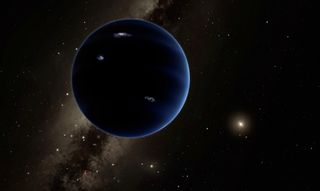Another search for Planet 9 comes up empty
'Results ... are generally consistent with other null searches for Planet 9.'

A theorized huge, ninth planet beyond the orbit of Neptune once again wasn't found in a new survey of the solar system's outer reaches.
Astronomers scanned a large portion of the sky using the 6-meter Atacama Cosmology Telescope (ACT) in Chile to search for Planet 9. The quest came up empty, according to the scientists behind the research, although they acknowledged that more sensitive searches would make the result more definitive.
"Their search found many tentative candidate sources — about 3,500 of them — but none could be confirmed, and there were no statistically significant detections," the Harvard-Smithsonian Center for Astrophysics, a participating institution in the research, said in a release March 11.
Related: Does Planet Nine really exist?
That said, in the scanned area of the sky, scientists were "able to exclude with 95% confidence" a world with the supposed properties of Planet 9, the release added, "results that are generally consistent with other null searches for Planet 9."
It's the latest in a string of fruitless searches in the past decade, after a team of astronomers Chadwick A. Trujillo (then of Gemini Observatory) and Scott S. Sheppard (of the Carnegie Institution for Science) argued in Nature in 2014 that such a large world might explain a strange large gravity source in deep solar space.
The team behind the new research acknowledged how tough the search would be to find such a planet. In theory, Planet 9 appears to be five to 10 times the size of Earth and roughly 400 to 800 Earth-sun distances away from the sun. (The Earth and sun are on average, 93 million miles or 150 million kilometers apart.)
Get the Space.com Newsletter
Breaking space news, the latest updates on rocket launches, skywatching events and more!

A small planet so far away would be tough to spot in optical searches because the world would see very little sunlight at such great orbital distances. Even searching for infrared or heat signatures is tough, as infrared surveys such as the Wide-field Infrared Explorer (WISE) were unable to find Planet 9 in past attempts, the team noted.
The newly used Atacama Cosmology Telescope usually looks for the signature of the Big Bang, also known as cosmic microwave background radiation. But repurposing the telescope for Planet 9 had value as "its relatively high angular resolution and sensitivity makes it suitable for this type of search," the team stated.
The astronomers looked at 87% of the sky accessible from the southern hemisphere over six years, and then processed the images to search for faint sources. Although the results so far have come up empty, the team acknowledged in the statement that more advanced surveys may yield more information.
The researchers are particularly excited to see the results of a project based in Chile called the Simons Observatory that will also spend most of its time spending the cosmic microwave background.
A study based on the research was published in December 2021 in the Astrophysical Journal.
Correction: This article was corrected to credit the first paper about a perturbing planet in Nature.
Follow Elizabeth Howell on Twitter @howellspace. Follow us on Twitter @Spacedotcom or Facebook.
Join our Space Forums to keep talking space on the latest missions, night sky and more! And if you have a news tip, correction or comment, let us know at: community@space.com.

Elizabeth Howell (she/her), Ph.D., is a staff writer in the spaceflight channel since 2022 covering diversity, education and gaming as well. She was contributing writer for Space.com for 10 years before joining full-time. Elizabeth's reporting includes multiple exclusives with the White House and Office of the Vice-President of the United States, an exclusive conversation with aspiring space tourist (and NSYNC bassist) Lance Bass, speaking several times with the International Space Station, witnessing five human spaceflight launches on two continents, flying parabolic, working inside a spacesuit, and participating in a simulated Mars mission. Her latest book, "Why Am I Taller?", is co-written with astronaut Dave Williams. Elizabeth holds a Ph.D. and M.Sc. in Space Studies from the University of North Dakota, a Bachelor of Journalism from Canada's Carleton University and a Bachelor of History from Canada's Athabasca University. Elizabeth is also a post-secondary instructor in communications and science at several institutions since 2015; her experience includes developing and teaching an astronomy course at Canada's Algonquin College (with Indigenous content as well) to more than 1,000 students since 2020. Elizabeth first got interested in space after watching the movie Apollo 13 in 1996, and still wants to be an astronaut someday. Mastodon: https://qoto.org/@howellspace

